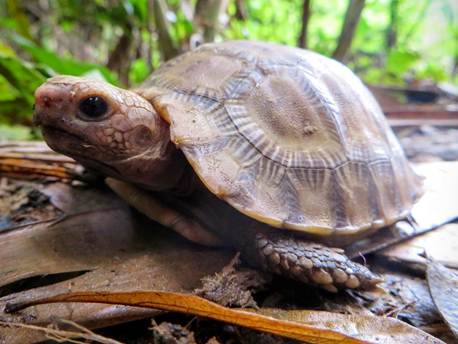Species Profile: Asian Giant Tortoise
- Scientific name: Manouria emys
- Status: Critically Endangered (IUCN Red List)
- Significance:
- Largest tortoise in mainland Asia
- Indicator species for tropical forest health
- Native Range: India (NE states), Bangladesh, Myanmar, Thailand, Malaysia, and parts of Indonesia
- Threats:
- Poaching for meat and pet trade
- Habitat destruction (shifting cultivation, deforestation)
- Slow reproductive rate and long maturation period
Relevance : GS 3(Environment and Ecology)

What Happened: Key Highlights
- Location: Zeliang Community Reserve, Peren district, Nagaland
- Event: Release of 10 individuals of Asian giant tortoise
- Source: Bred and raised in Nagaland Zoological Park, Chümoukedima
- Date of Reintroduction: August 2025 (community-led event)
- Partners Involved:
- Nagaland Forest Department
- India Turtle Conservation Programme (ITCP)
- Local Zeliang community
Scientific & Ecological Aspects
- Soft-Release Strategy:
- Tortoises were placed in a pre-constructed enclosure within the reserve
- Aim: Encourage site fidelity (the tendency to remain or return to the same site)
- Reduces post-release mortality and improves habitat acclimatization
- Habitat Restoration:
- Involves protecting forest undergrowth and controlling human intrusion
- Ensures microhabitats (leaf litter, moist soil) crucial for the species’ survival
Background: Decline in Nagaland
- Once found widely across Nagaland, especially in community forests
- Over last 10–15 years, populations collapsed due to:
- Illegal hunting for meat (considered a delicacy)
- Habitat degradation (logging, land-use change)
- Lack of awareness about its ecological importance
Role of Local Communities
- Community-Led Conservation:
- Zeliang tribe and local forest users involved in surveillance and protection
- Building community pride through cultural-symbolic value of the species
- Nagaland’s Model:
- ~90% forest is community-owned → Community reserves critical to conservation success
- Examples: Sendenyu, Khonoma, and Fakim wildlife models
Institutional Support & National Significance
- India Turtle Conservation Programme (ITCP):
- Collaborative initiative by Turtle Survival Alliance (TSA) & Wildlife Conservation Society (WCS)-India
- Supports breeding, release, and habitat protection
- Forest Department of Nagaland:
- Active in mobilizing locals, policy backing for soft-release, long-term monitoring
- Zoological Parks as Ex-situ Breeding Grounds:
- Nagaland Zoo plays pivotal role in captive breeding & reintroduction
- Aligns with India’s National Wildlife Action Plan (2017–2031)
Broader Conservation Relevance
- Aligns with SDGs:
- SDG 15 (Life on Land): Protect, restore, and promote sustainable use of terrestrial ecosystems
- SDG 13 (Climate Action): Forest conservation as a climate buffer
- Restoring Keystone Species:
- Herbivorous tortoises regulate forest floor ecology, seed dispersal
- Promote ecological balance in Eastern Himalayan biodiversity hotspot
- Precedent for Rewilding:
- One of India’s first structured soft-releases for a critically endangered tortoise
- Builds replicable model for Indian Star Tortoise, Black Softshell Turtle, etc.
Way Forward
- Long-Term Monitoring:
- Radio-tagging and periodic health assessments needed
- Community Incentives:
- Eco-tourism, forest-based livelihoods can ensure sustained local engagement
- Legal Support:
- Enforcing Wildlife Protection Act, 1972 in community-owned forests
- Scaling the Model:
- Replicate in Arunachal, Assam, Mizoram where habitats still exist
- Education & Awareness:
- Integrate with tribal schools and youth groups to reduce future poaching risk



